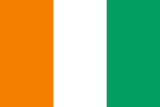Ivory Coast

About Ivory Coast
Ivory Coast, also known as Côte d'Ivoire, officially the Republic of Côte d'Ivoire, is a country located on the south coast of West Africa. Ivory Coast's political capital is Yamoussoukro in the centre of the country, while its economic capital and largest city is the port city of Abidjan. It borders Guinea to the northwest, Liberia to the west, Mali to the northwest, Burkina Faso to the northeast, Ghana to the east, and the Gulf of Guinea (Atlantic Ocean) to the south. The official language of the republic is French, with local indigenous languages also being widely used that include Baoulé, Dioula, Dan, Anyin, and Cebaara Senufo. In total, there are around 78 different languages spoken in Ivory Coast. The country has large populations of the adherents of Christianity, Islam and various indigenous religions.
Before its colonization by Europeans, Ivory Coast was home to several states, including Gyaaman, the Kong Empire and Baoulé. The area became a protectorate of France in 1843 and was consolidated as a French colony in 1893 amid the European scramble for Africa. It achieved independence in 1960, led by Félix Houphouët-Boigny, who ruled the country until 1993. Relatively stable by regional standards, Ivory Coast established close political and economic ties with its West African neighbours while at the same time maintaining close relations to the West, especially France. Its stability took a hit by a coup d'état in 1999 and two civil wars, first between 2002 and 2007 and again during 2010–2011. In 2000, the country adopted a new constitution.Ivory Coast is a republic with strong executive power vested in its president. Through the production of coffee and cocoa, the country was an economic powerhouse in West Africa during the 1960s and 1970s, though it went through an economic crisis in the 1980s, contributing to a period of political and social turmoil. It was not until around 2014 that the gross domestic product again reached the level of its peak in the 1970s. In 2020, Ivory Coast was the world's largest exporter of cocoa beans and had high levels of income for its region. In the 21st century, the Ivorian economy has been largely market-based, and it still relies heavily on agriculture, with smallholder cash-crop production being predominant.
Yamoussoukro
Yamoussoukro (French pronunciation: [jamusukʁo], locally [jamsokʁo]) is the de jure capital of Ivory Coast and an autonomous district. As of the 2014 census, Yamoussoukro is the fifth most populous city in Ivory Coast with a population of 355,573 inhabitants. Located 240 kilometers (150 mi) north-west of Abidjan, Yamoussoukro covers 3,500 square kilometers (1,400 sq mi) among rolling hills and plains.
Yamoussoukro became the legal capital of the Ivory Coast in 1983, although the former capital Abidjan retains several political functions. Prior to 2011, what is now the district of Yamoussoukro was part of Lacs Region. The district was created in 2011 and is split into the departments of Attiégouakro and Yamoussoukro. In total, the district contains 169 settlements. Yamoussoukro is a sub-prefecture in Yamoussoukro Department and is also a commune: since 2012, the city of Yamassoukro has been the sole commune in the autonomous district of Yamoussoukro.